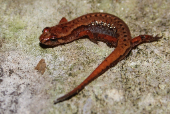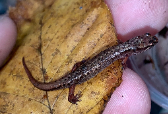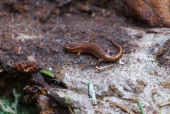Northern Pygmy Salamander (Desmognathus organi)
Description: Desmognathus organi can be identified by its small size, averaging only 40 to 60 mm total length, and its distinct herringbone pattern on the dorsal side and copper colored eyelids, which are traits only shared with D. wrighti. Dorsal coloration can vary from dark reddish-brown to light brown, with a much lighter ventral surface. Characteristic of the Desmognathus species, there is a light colored eye stripe to the jaw, and the hindlimbs are longer and more robust than the forelimbs. However, unlike most of the other Desmognathus species, the tail is round in cross section and is also less than half of the total length of the salamander, this seems to be characteristic of these smaller species, including the southern pygmy (D. wrighti) and seepage salamander (D. aeneus). In contrast to D. wrighti, D. organi salamanders are generally slightly larger in size, with the maximum total length of adult D. wrighti being 50 mm whereas most adult D. organi exceed 50 mm. They also have wider heads than D. wrighti, and D. organi females tend to be larger than males. This sexual dimorphism is absent in D. wrighti.
Habitat: Populations of Desmognathus organi can be found in high elevation spruce-fir and hardwood forest habitats in the Blue Ridge Mountains. It is rare to find this species below 1500m. It is thought that historically the distribution of spruce-fir forests and subsequent populations of pygmy salamanders may have been continuous at one point, but as the climate became warmer and drier populations became isolated on the high elevation "islands" that we see today.
Range: This species occurs north and east of the French Broad river, ranging from the southwesternmost part of Virginia, particularly Mount Rogers and Whitetop Mountain, to the ridges of western North Carolina and eastern Tennessee. Its sister species, D. wrighti, occurs at similar elevations and habitats south and west of the French Broad to the Georgia state line.
Found in these States:
NC |
TN |
VA
Diet: D. organi will be mostly active at night and when it rains, and will hunt small invertebrates such as mites, moths, small beetles, and spiders
Reproduction: Desmognathus organi undergoes direct development to bypass the aquatic larval stage. This is a unique trait of D. organi and the other small Desmognathus species D. wrighti and D. aeneus, allowing them to be the most terrestrial species of the genus. Most Desmognathus species rely on a water source to lay their eggs and mature in the water for the first stage of their lives, but by hatching as small adult salamanders.
Males reach reproductive maturity by 3.5 yrs old, and females mature by 4.5. Mating occurs in fall and spring, and involves the males biting on to the female's tail to initiate the mating process. In a typical Plethodontidae mating behaviour, the pair will then walk in a line with the female straddling the male's tail and the male will then deposit a spermatophore on the ground and guide the female to it so she may pick it up with her cloaca. This is how they achieve internal fertilization, and the female will lay a clutch averaging 3 to 10 eggs in a seepage area or wherever she can find moist ground and stay nearby to protect them. Finding a moist place to lay the eggs is only necessary so the eggs do not dry out, as once the eggs hatch the hatchlings will not live in water.
Status: The species' extent of occurrence (EOO) is 7,068 km2 and there is localised decline in the extent and quality of its habitat. However it is thought to occur in more than ten threat-defined locations and its population is probably not severely fragmented. It is therefore close to qualifying for Vulnerable under criterion B1 and is listed as Near Threatened.
»» Kingdom: Animalia - Animals
»» Phylum: Chordata - Chordates
»» Subphylum: Vertebrata - Vertebrates
»» Class: Amphibia - (Amphibians)
»» Order: Caudata - Salamanders
»» Family: Plethodontidae - Lungless Salamanders
»» Genus: Desmognathus
»» Species: Desmognathus organi - Northern Pygmy Salamander
This article uses material from the Wikipedia article "Northern Pygmy Salamander", which is released under the Creative Commons Attribution-Share-Alike License 3.0. Content may have been omitted from the original, but no content has been changed or extended.
|












